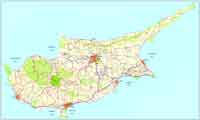|
|
The Lusignan family originated in Poitou in western France, and in the late 12th century came to rule the Kingdom of Jerusalem and the Kingdom of Cyprus. Origins The family originated from the Château de Lusignan, near Poitiers. According to legend the castle was built by the folklore water-spirit Melusine. The lords of the castle were counts of La Marche, over which they frequently fought with the counts of Angoulême. Count Hugh le Brun ("Hugh the Swarthy"), like most of the lords of Poitou, backed Arthur of Brittany as the better heir to Richard Lionheart when John Lackland acceded to the throne of England in 1199. Eleanor of Aquitaine traded English claims for their support of John. To secure his position in La Marche, the widowed Hugh arranged a betrothal with the daughter of his next rival of Angoulême, no more than a child, whom John however himself married in August 1200, and deprived Hugh of La Marche and his brother of Eu in Normandy. The aggrieved Lusignans turned to their liege lord, Philip Augustus, King of France. Philip demanded John's presence— a tactical impossibility— and declared John a contumaceous vassal. As the Lusignan allies managed to detain both Arthur and Eleanor, John surprised their unprepared forces at the castle of Mirabeau, in July 1202, and took Hugh prisoner with 200 more of Poitou's fighting men. King John's savage treatment of the captives turned the tide against himself, and his French barons began to desert him in droves. Thus the Lusignans' diplomatic rebellion led directly to the loss of half of England's French territory, which was soon incorporated into France by Philip Augustus (The other "half", Aquitaine, was the possession of Eleanor, who was still alive).
Crusader kings The Lusignans were among the French nobles who made great careers in the Crusades. An ancestor of the later Lusignan dynasty in the Holy Land, Hugh of Lusignan, was killed in the east during the Crusade of 1101. Another Hugh arrived in the 1160s and was captured in a battle with Nur ad-Din. In the 1170s, the brothers Guy and Amalric arrived in Jerusalem, having been expelled by Richard Lionheart (at that point, acting Duke of Aquitaine) from his realm, which meant that they were not allowed to sojourn at their home near Poitiers. In the Holy Land, they allied themselves with Raynald of Chatillon, who led one of the factions currently dividing the kingdom. Raynald's faction was mostly composed of newcomers (also known as the "court party" due to their influence in the royal court), while the opposing faction of old established families was led by Raymond III of Tripoli. In 1179 Amalric became constable of Jerusalem, with the support of Agnes of Courtenay, mother of the then King (Amalric was supposedly having an affair with Agnes). The court party also made Guy regent of the kingdom in 1180. Guy became king himself in 1186 as consort of the new Queen, Sibylla of Jerusalem. Guy's term as king is generally seen as a disaster; he was defeated by Saladin at the Battle of Hattin in 1187, and fled to Cyprus as Saladin reconquered almost the entire kingdom. On Cyprus, in 1191, he met Richard, now king of England and a leader of the Third Crusade. Richard supported Guy's claim to the kingdom of Jerusalem, though Sibylla had died in 1190, but in the aftermath of the crusade Conrad of Montferrat had the support of the majority of nobles. Instead, Richard sold Guy the island of Cyprus. Guy thereby became the first Latin lord of Cyprus. Amalric succeeded Guy in Cyprus, and also became King of Jerusalem in 1197. Amalric was responsible for establishing the Roman Catholic Church on Cyprus. The male line of the Lusignans in the Levant died out in 1267 with Hugh II of Cyprus, Amalric's great-grandson (the male line continued in France until 1307). At that point, Hugh of Antioch, whose maternal grandfather had been Hugh I of Cyprus, a male heir of the original Lusignan dynasty, took the name Lusignan, thus founding the second House of Lusignan, and managed to succeed his deceased cousin as King of Cyprus. These "new" Lusignans remained in control of Cyprus until 1489; in Jerusalem (or, more accurately, Acre), they ruled from 1268 until the fall of the city in 1291, after an interlude (1228-1268) during which the Hohenstaufen dynasty officially held the kingdom. Also after 1291 the Lusignans continued to claim the lost Jerusalem, and occasionally attempted to organize crusades to recapture territory on the mainland. In the 13th century the Lusignans also intermarried with the royal families of the Principality of Antioch and the Armenian Kingdom of Cilicia.
Lords of Lusignan
Other Lusignans of renown
Second House of Lusignan (in Cyprus etc)
Retrieved from "http://en.wikipedia.org"

|
|
||||||||||||||
|
|

